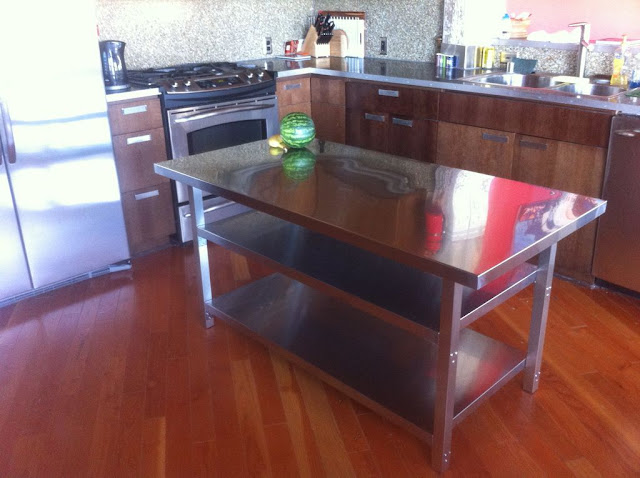Materials: Ikea Hyttan Table Top (1 large, 2 small), 4 Vika Moliden Legs
1x Ikea Hyttan Table Top, 59" x 29 1/2" x 1 5/8". http://www.ikea.com/us/en/catalog/products/40115532/
2x Ikea Hyttan Table Top, 47 1/2" x 23 5/8" x 1 5/8". http://www.ikea.com/us/en/catalog/products/20115533/
4x Ikea Vika Moliden Legs, 1 5/8" x 1 5/8" x 27 1/2". http://www.ikea.com/us/en/catalog/products/30177912/
General hardware ($15)
8x L-Brackets
Nuts, bolts, and washers for connecting the L-Brackets to the legs. The number you'll need will depend on how many holes the L-Brackets have.
Wood screws for connecting the L-Brackets to the shelves
(The Ikea legs come with wood screws for mounting them to the top, so you won't need to get those.)
Optional Casters for rolling cart ($20)
You'll want casters with a "threaded stem", which just means that it mounts with a bolt. The ones I found were locking wheels with a 1.5" stem. If you get casters with a longer stem, make sure to consider where the bolts will go through the legs for the bottom shelf and that it won't collide with the caster's bolt.
Total: $425 (including optional casters)
Step 1: Drilling L-Bracket holes in legs
I wish I had had a drill press for this step, but I managed to get by with a hand drill and working on top of a stack of cardboard on my kitchen floor.
For a sturdy connection, the L-Brackets need to be bolted all the way through the (hollow) legs. I tried a couple different strategies but ultimately found the most success with tightly taping the L-Brackets where I wanted them on the leg, then drilling through one face of the leg, through the holes in the bracket. I then removed the bracket, and drilled through the freshly created holes and out through the back side of the leg, using the level on my drill as a loose guide.
It's important to drill all the pilot holes for the top shelf from the same side as those for the bottom shelf. The holes drilled on the side with the bracket are spot-on, where-as the holes on the other side may be a little misaligned if you didn't drill perfectly straight through. The error could very easily make the bracket not fit on the backside, so just be consistent and you won't have to worry about a problem when you go to bolt it all together. You'll run into this problem also if the holes on the brackets aren't symmetrical and you drilled from both sides.
Step 2: Attach shelves to legs
Once you get all the legs drilled, you can go ahead and bolt the L-Brackets onto them tightly. I didn't think to take any pictures of this step but it is straightforward.
Next, set one of the small shelves upside-down on a work surface. Set the leg on the shelf and mark the center of the holes you'll need to drill. Be sure to choose a drill bit that is smaller than the threads on your wood screws so your sure that there will be particle board left for them to grip when you tighten everything down. Also, set the drill bit deep enough into your drill so that if you drill all the way down, it will have nearly reached the finished surface, but not have damaged it!
As you can see, my brackets needed to be mounted through the edge where the metal top wraps around. To drill these holes accurately, use a hammer and nail to indent the metal where you want to drill. This will help keep the drill bit from sliding around when you are trying to drill through it. When you first break through the metal, you'll think the edge is hollow, but it isn't. The particle board on the inside is just a little deeper.
After you've drilled the pilot holes for the first shelf, set it aside and do the same for the next shelf. You won't want to start connecting the shelves until everything is pre-drilled.
Finally, mount all the legs to the shelves, using washers (as spacers) around the joints that are directly on the plywood portion (not on the metal frame.)
Step 3: Attach top
Lay the table top upside-down on the floor (on top of the cardboard box and plastic bag that it came in, to protect it.)
Flip the assembled 2-shelf-and-legs unit upside down onto the underside of the table top.
Measure everything meticulously and center the unit in all directions.
Trace around the bean-shaped mounting holes of the legs with a pencil
Move the assembled unit and drill all the pilot holes. Again, carefully check to make sure your drill bit is set deep enough into the drill so that it can't possibly drill through to the finished side of the top.
Set the assembled unit back on the top, center, and screw it down.
Step 4: Attach caster wheels (Optional)
The plastic bottom floor protector cap will come off if you can get something thin like a knife or scissor blade between the metal and the cap and work it back and forth.
Once the cap is off, drill a hole just large enough for your caster's threaded stem through the plastic cap, put the caster in and bolt it down. Re-insert the cap back onto the leg. Repeat for each remaining leg.
See step by step instructables for the kitchen island cart.
~ Rob Meyer, Seattle, WA























Post A Comment:
0 comments:
Post a Comment